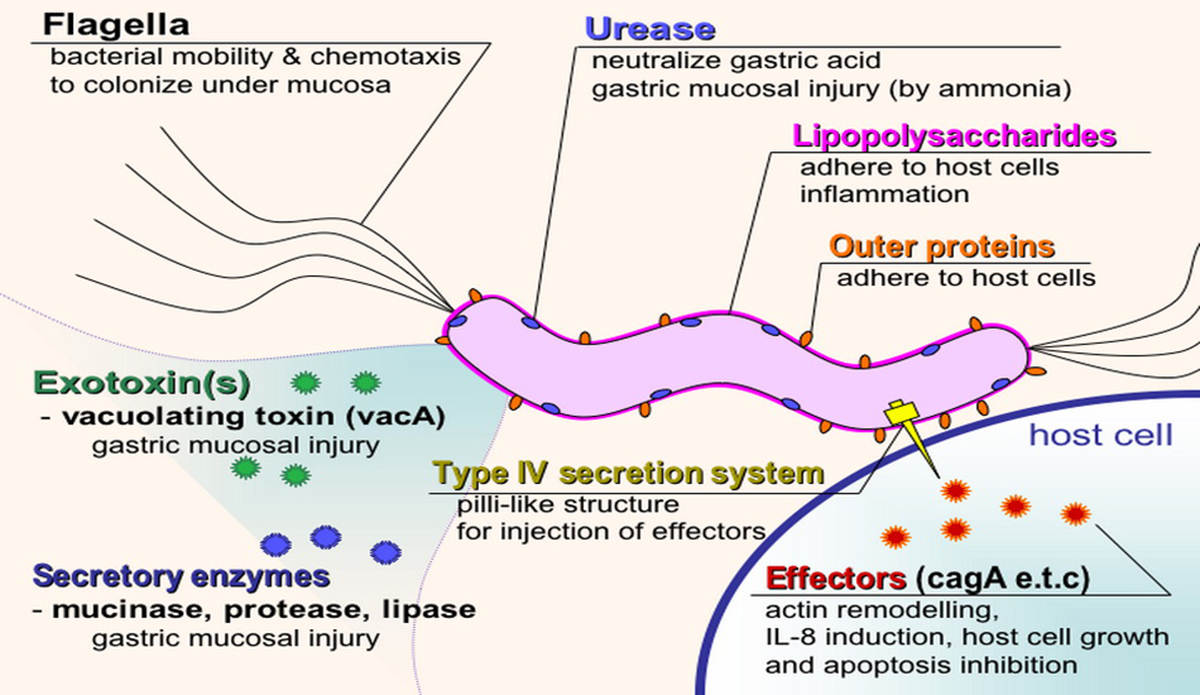Table of Contents
Helicobacter Pylori aka H. Pylori
Helicobacter pylorus (H. pylori) is a bacterium from the family Helicobacteraceae. It is normally present in the stomach.

H. pylori infections are usually the result of consuming contaminated food or water. It is spread via contaminated fecal matter.
H. Pylori and Peptic Ulcers: Nobel Prize of 2005
The fact that H. pylori cause complications such as chronic gastritis and ulcers was established in 1982 by two Australian scientists, Barry Marshall and Robin Warren. For their outstanding work and unexpected discovery, the Nobel Prize of 2005 in Physiology or Medicine was awarded to both these scientists.
Their research dismissed the conventional belief that ulcers were a result of stress and lifestyle factors alone. They established that gastritis and ulceration of the stomach or duodenum had an underlying microbial cause. Infections are more common in developing countries. Since over 80% of affected individuals exhibit no signs or symptoms, research in this aspect is still in progress.
Moreover, the research of Marshall and Warren, along with the work of other scientists, proved that inhibition of gastric acid production alone was not a complete cure for ulcers. In order to completely heal the ulcer and inflammation, the bacteria had to be eradicated. Further studies via antibiotic treatments, epidemiological studies, and human volunteers have further strengthened the link between H. pylori and gastric illness.
H. Pylori Infection: A Chronic Condition
As mentioned before, about 50% of humans carry this gram-negative bacterium in their stomachs. In developing countries, the majority of people are usually infected.
However, it has been shown that an H. Pylori infection is mostly contracted at the early childhood stages. The most common route of infection is from the mother to the child.
This chronic condition starts at the antrum (lower part of the stomach) and, as now confirmed, it will result in chronic inflammation as well.
H. Pylori infection: Asymptomatic or Symptomatic
Whether the infection will remain asymptomatic or will cause problems depends on its severity and location in the stomach. Usually, 10-15% of individuals generally develop ulcers, more commonly in the duodenum rather than the stomach. It is now believed that chronic inflammation from H. pylori infection results in excess acid production by the non-infected upper region of the stomach. This makes the infected part more vulnerable to an ulcer, bleeding, and perforation.
H. Pylori and Stomach Cancer
Stomach cancer is the fourth most common type of cancer globally. In some rare cases, H. pylorus has been seen to infect the corpus region of the stomach. This causes a more pronounced inflammation and increases the chances of a corpus ulcer as well as stomach cancer. Moreover, inflammation poses the risk of a significant type of lymphatic neoplasm in the stomach known as MALT (mucosa associated lymphoid tissue) lymphoma.
H. Pylori Strains: Harmless and Harmful versions
The different strains of H. pylori that exist differ significantly in various aspects, such as how they adhere to the stomach lining and their ability to trigger an inflammation.
Research relating to the underlying genetic variations that cause these differences is being conducted. This will help in developing target-specific treatment options.
See Also: Helicobacter pylori: The Bacteria that Cause Ulcers
H. Pylori and Humans: A case of Genetic Predisposition
Similar to the concept of different strains of H. pylori, genetic variations among humans also play a key role in determining their susceptibility to illness. Research is now being focused on the minor genetic polymorphisms that affect the way an individual fights bacterial infections. Findings could help single-out high-risk patients. Studies have been conducted on an animal model, the Mongolian gerbil.
- Photo courtesy of Y_tambe by Wikimedia Commons : commons.wikimedia.org/wiki/File:H_pylori_virulence_factors_en.png
- Photo courtesy of Mishio by Flickr : www.flickr.com/photos/cliche_photography/3345322823


Your thoughts on this